Part of an excellent map of Trinity College in 1902 from Digital Durham's collection. (I have to wonder if it was student-drawn - or perhaps professor drawn, given that "Favorite Loafing Place" is noted. Update - it was drawn by William Budd, Trinity College Student and later founder of the Budd-Piper Roofing Company. His house still stands at 903 S. Duke St.)
The map is oriented with west at the top.
(Courtesy Duke Rare Book and Manuscript Collection. Scanned by Digital Durham)
The Pegram house may be the only extant historic structure in Durham to have been moved not once, but twice.
Built in 1891, the Pegram house was one of five houses built during the original construction of the Durham campus of Trinity College as housing for faculty. These houses: the Pegram, Cranford, Bassett, Merritt, and Mims houses (for the professors that originally lived in the houses) were located along "Faculty Row", at the southeast corner of the campus. Although the configuration of now-Duke University East Campus has changed significantly, structures visible in the above map still in their original location include Epworth Hall, the Pavillion, and the Roney Fountain. N. Guess Road was later renamed Buchanan Blvd., and the original location of Watts Hospital is visible at the lower left corner.
1913 Sanborn map overlaid on Google imagery, showing the location of Faculty Row relative to present day. I've placed a red arrow to show the Pegram house.
View from the tower of the original Washington Duke building, 1897, looking southeast towards downtown. The Pegram house is in the left foreground. In the immediate background is the original Watts Hospital
Contractor TS Christian built the house for William H. Pegram, first a student, and later a professor at Trinity College when it was located in Randolph County, after it moved to Durham County, and after it became Duke University.
Pegram was born August 18, 1846, at Chalk Level in Harnett County and fought for the Confederacy during the Civil War. He began teaching school immediately after the war, and in 1869, he enrolled at Trinity College. After graduation in 1873, he began working as a tutor of Natural Science at the college and became a full professor the following year. Primarily a teacher of chemistry, he would also teach astronomy, physics, geology, and even English during his career. He also coached the debate team.
Per the Pegram Family website:
"According to an unsigned history of the physics departments, c. 1905,
'In 1873 a bright young man, just out of college and full of the fine enthusiasm of youth was appointed to teach the sciences. It did not take him long to doff his coat, roll up his sleeves and resolve to make something happened. This youth was William H. Pegram. The records do not show whether this fine enthusiasm was fundamentally excited by a love of pure science or by a love of the President's daughter. The fact is well-established, however, that through it he won the unqualified approval of the President and also of the President's daughter, and thereby won for himself a career in science.'"
His wife was Emma Craven, daughter of the one-time president of Trinity College, Braxton Craven, for whom Craven Memorial Hall (now demolished) would be named on the Durham campus. Pegram and his wife moved to Durham with the college in 1892. After 1900, Pegram was able to narrow his focus to the teaching of chemistry. He and his wife would have 5 children, all eventual graduates of Trinity College.
Per the Pegram Family Website:
"In his obituary in the Alumni Register a conversation between Washington Duke, wealthy founder of American Tobacco Company and the modestly salaried Professor is reported. Washington Duke outlined his career's progress to Pegram who countered with: 'After my Civil War experience, I spent four years on my father's farm and then four years in Trinity College, graduated 1873, was called the same year to the chair of Natural Science in said College, and have been with it ever since. From this last statement you know my financial rating.' Duke saw the point and countered with 'Yes, but you have made something better than money; you have helped to make men.'"
Probably some solace to Pegram, but money was on his mind when, in 1916, the College told the professors on Faculty Row that their houses needed to go - if the correspondence between father and son Pegram is accurate, at the professors' expense.
Per the Pegram website:
"As the campus expanded, the faculty houses were moved across the street and scattered within Trinity Park. The Pegram house was moved to a lot apparently owned by Pegram at 308 Buchanan Blvd (then Guess Mill [sic] Road). In a letter to his father March 18, 1916, George Braxton Pegram wrote:
'Since hearing that you have to move your house I have been wondering how much it is going to cost and how much I may be able to help out on the expense. I should think the college ought to do the moving or at least best a good part of the expense, since putting professors out of their houses is really cutting their salaries down. If I remember rightly you have two lots on Guess Street, one of them unencumbered and I suppose you will move the house to that one, but I have only a very vague idea of what it might cost to move. We are perhaps in less strident financial circumstances with our house than last year, which moves me to hope to be of at least a little assistance to you.'
The cost of the move is not recorded, but it is known that the move was accomplished by placing the house on logs and pulling it with a team of horses.
George Pegram wrote again to his father concerning the move on Sept. 7, 1918:
'I wonder how your house moving progressed. Charles Edward, I believe it was, told me that the dining room and kitchen had already gone, but that you did not expect to move the house proper until some weeks later. You have probably taken a pleasure in seeing that the new foundations are at least as good as the old ones, so as to obviate somewhat the cracking tendency the house always had.'
I'm not sure why the College picked this point in time to boot the houses from campus, but it was about the same time the stone wall was erected around perimeter of the campus.
Pegram retired in 1919, although he remained a professor emeritus at the university, and particularly involved with the Chemistry Department after the school became Duke University. Pegram died in 1928, and is buried at the former Trinity College campus in Randolph County.
The Pegram house remained in his family until 1966, when the last of his unmarried children, Annie Pegram, died.
"On February 20, 1962 she had transferred, via trust, the house to NCNB. Following a suit filed by Greensboro College against NCNB, executor for Annie Pegram, it was sold at public auction on Nov. 22, 1966 for $11,500 to Frances G. Crabtree. She, in turn, sold it to Herndon Building Company, April 3, 1969. Threatened with demolition to make way for a parking lot [for the Erwin Apartments, built next door to the house in the 1930s that] Mr. Fred Herndon owned next door, he offered to move the house at his own expense and make it available to a citizens' group. The Durham Historic Preservation Society bought it and the 3120 square foot house was moved again in September, 1977 to [1019] Minerva Ave."
Pegram House on Buchanan Blvd., 03.15.77
(Courtesy The Herald-Sun Newspaper)
House move, 09.18.77
(Courtesy The Herald-Sun Newspaper)
House move, 09.18.77
(Courtesy The Herald-Sun Newspaper)
House move, 09.18.77
(Courtesy The Herald-Sun Newspaper)
House move, 09.18.77
(Courtesy The Herald-Sun Newspaper)
House move, 09.18.77
(Courtesy The Herald-Sun Newspaper)
House move, 09.18.77
(Courtesy The Herald-Sun Newspaper)
House move, 09.18.77
(Courtesy The Herald-Sun Newspaper)
House move, 09.18.77
(Courtesy The Herald-Sun Newspaper)
Don't know the story here, but this does not look good:
House move, 09.18.77
(Courtesy The Herald-Sun Newspaper)
House move, 09.18.77
(Courtesy The Herald-Sun Newspaper)
Fortunately, I know that the story had a happy ending.
Pegram House at 1019 Minerva, 1980.
The house remains standing and occupied at its third location.
Pegram House at 1019 Minerva, 10.03.09
The second location remains a parking lot for the Erwin Apartments. The walkway from the road is the only remaining evidence of the house at this location.
308 N Buchanan, 10.21.09
Original Location
Second Location
Present Location
36.004237,-78.910179

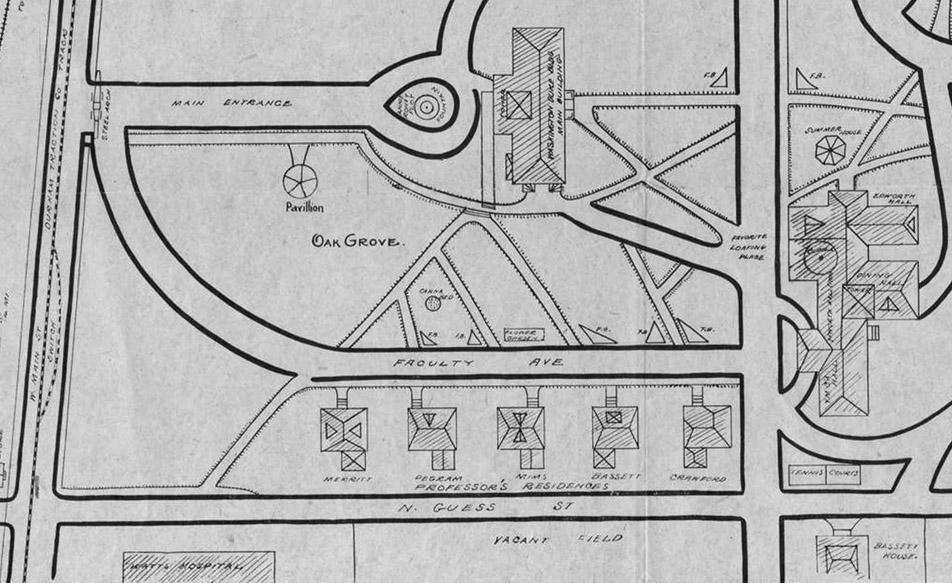
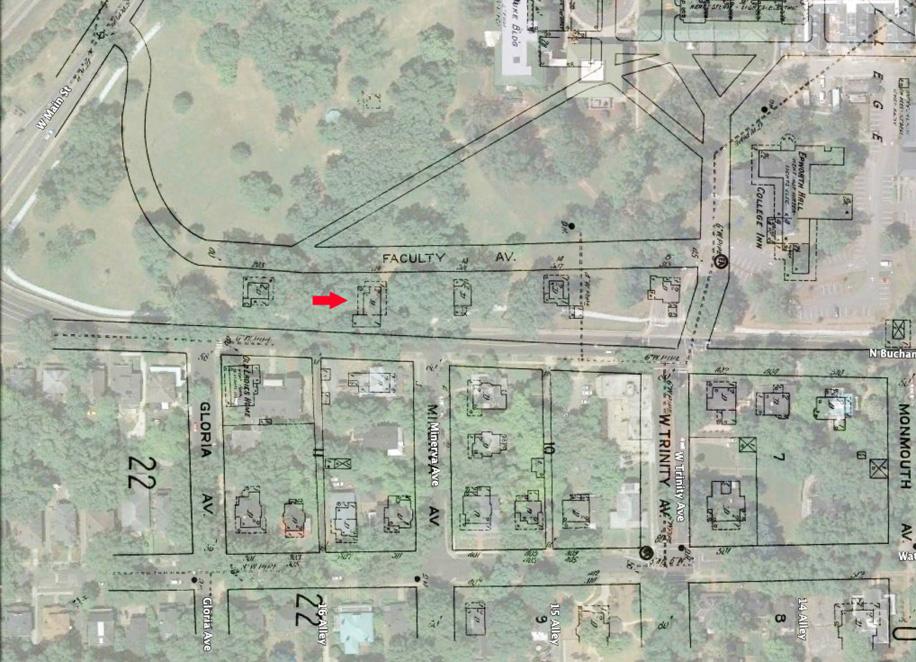
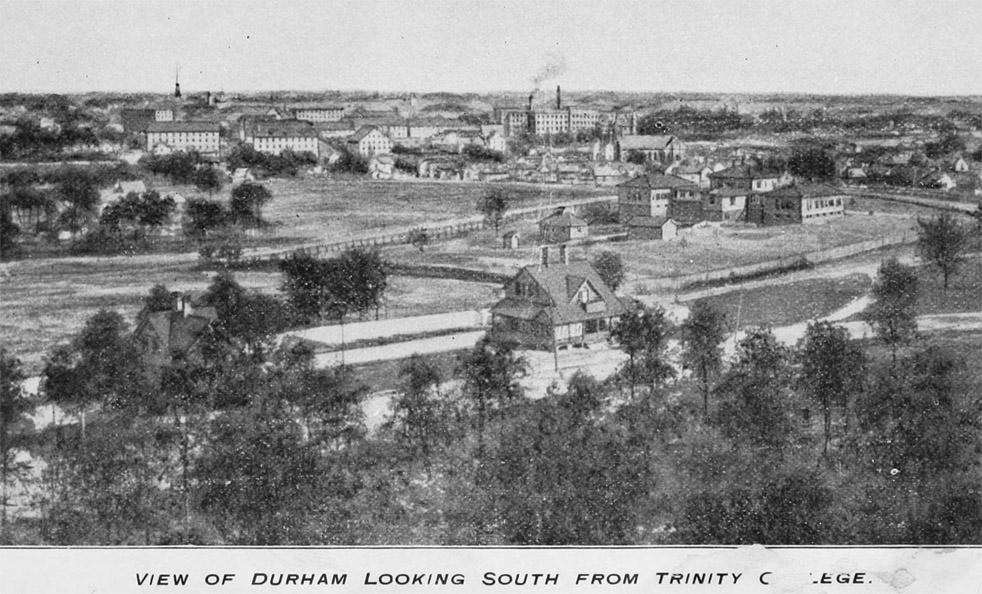
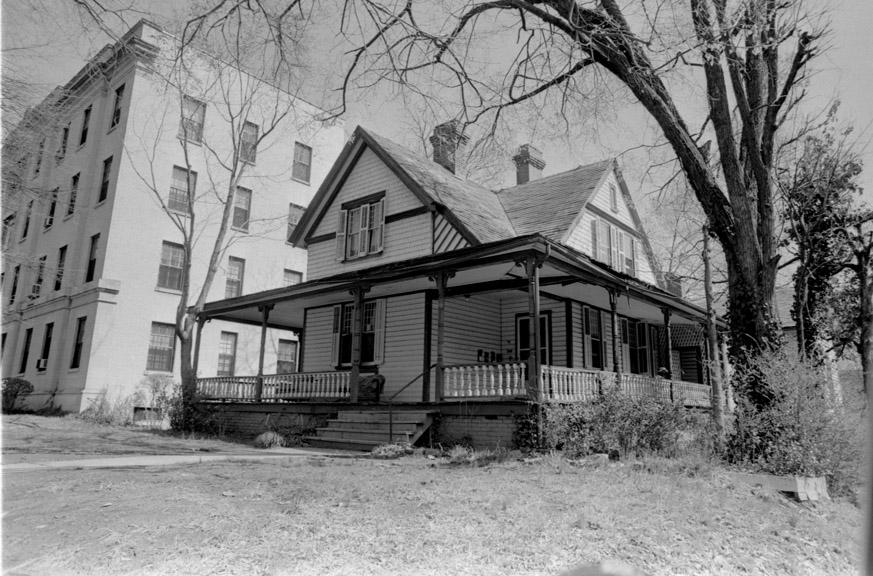


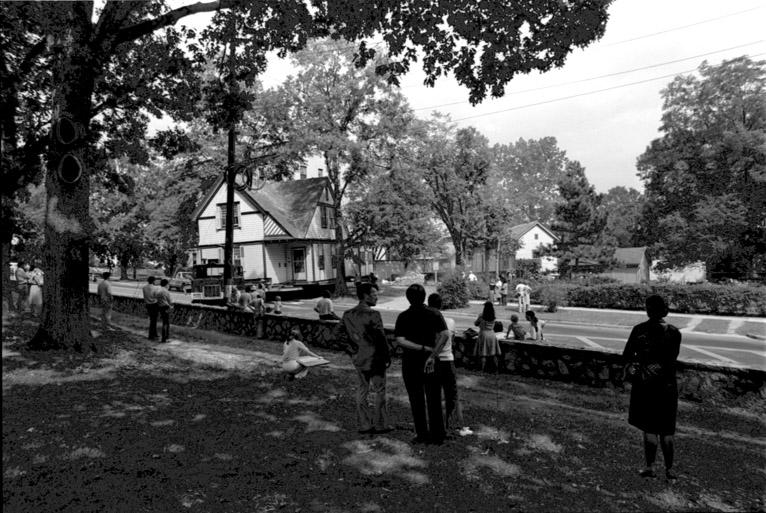
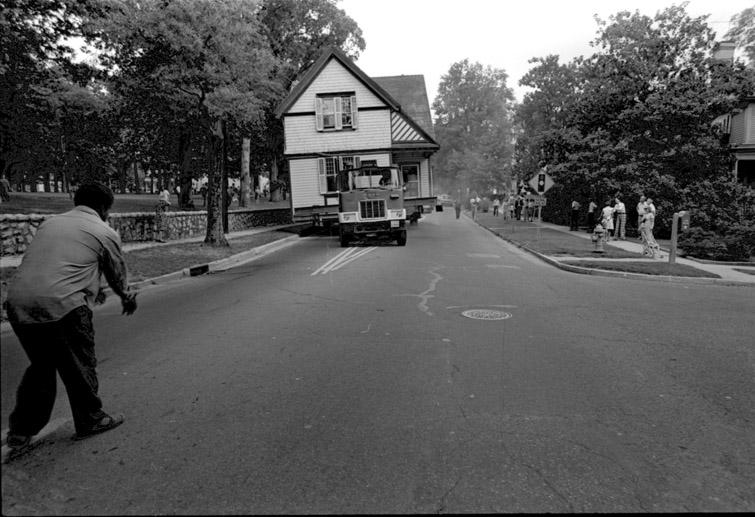
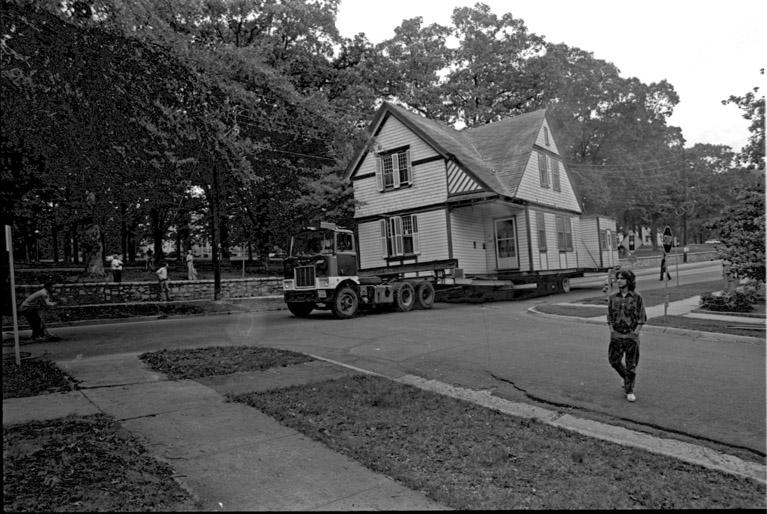

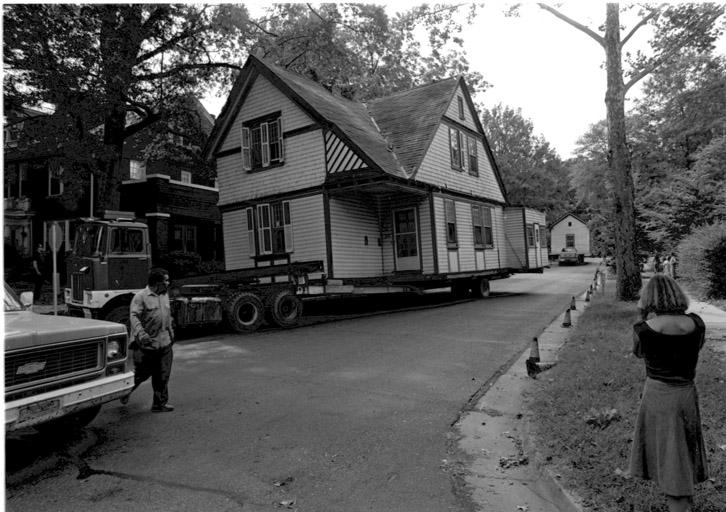
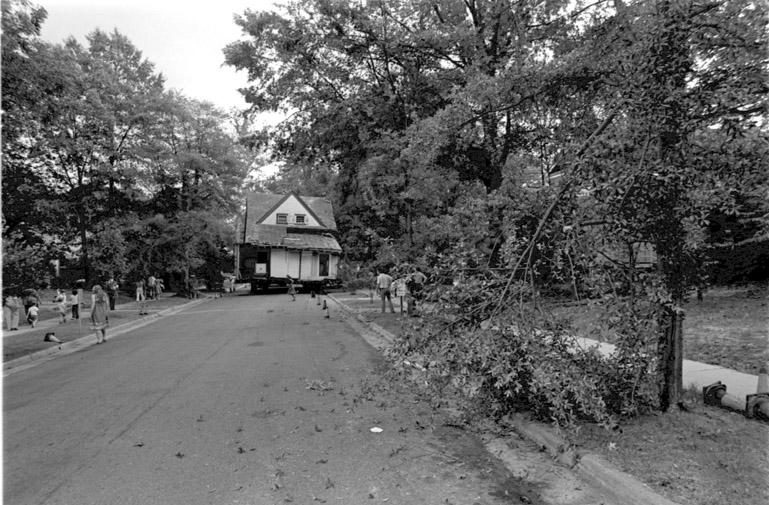
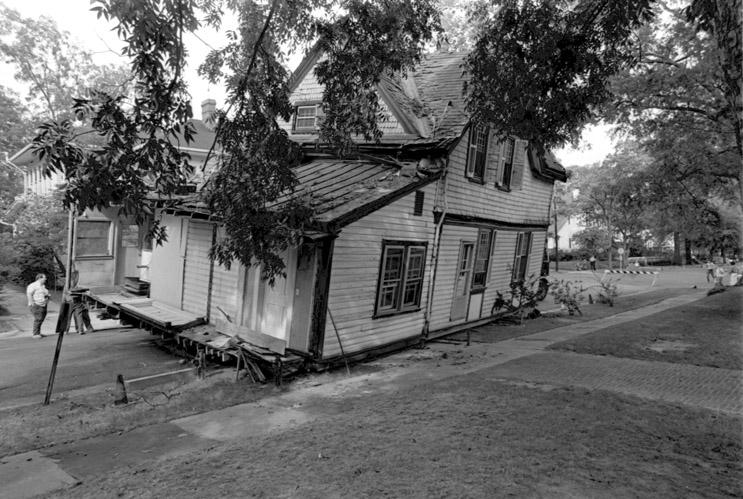
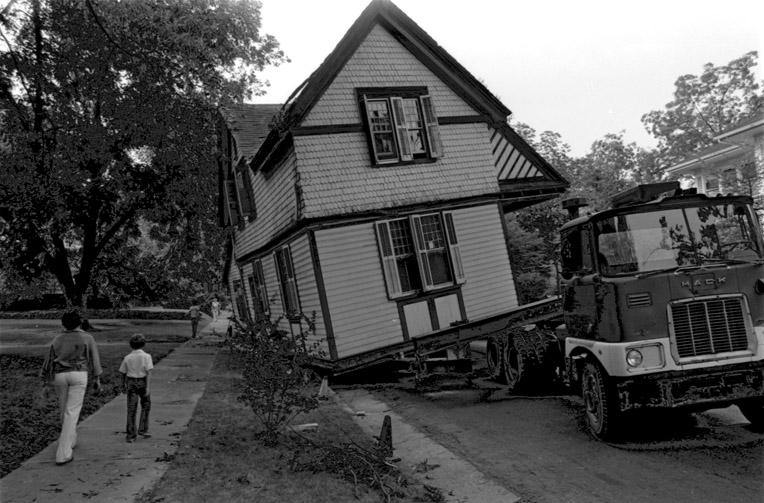
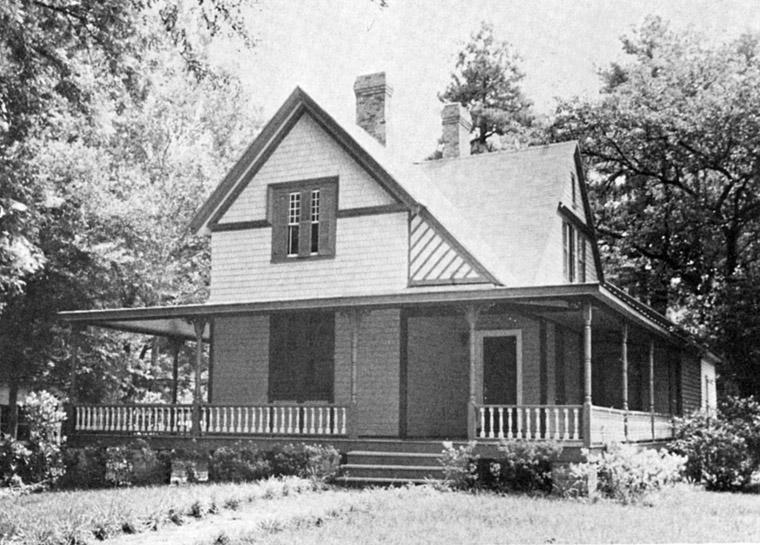
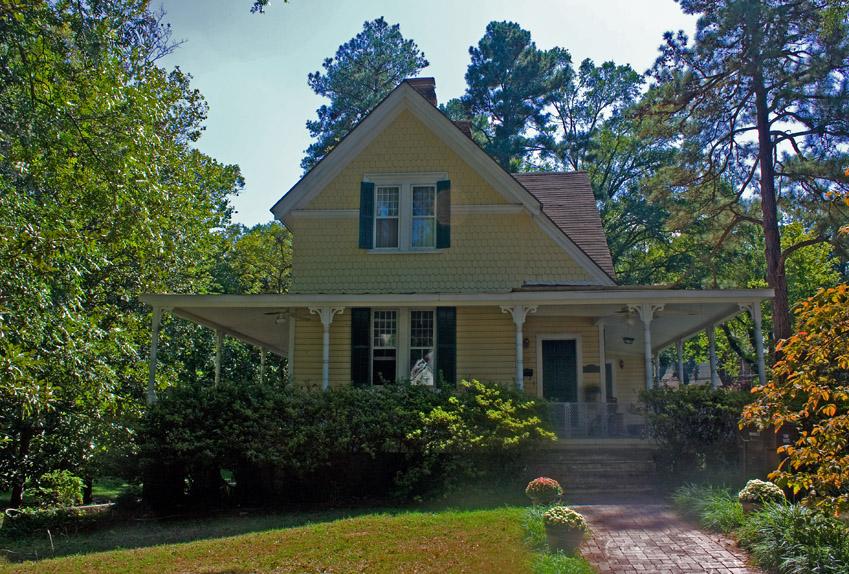
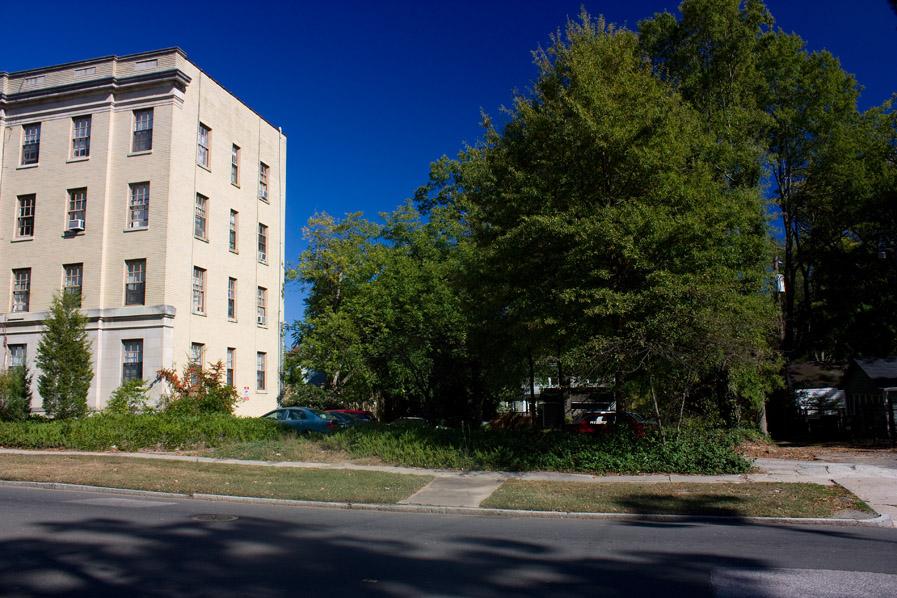
Comments
Submitted by John Schelp (not verified) on Mon, 2/15/2010 - 4:01pm
Love the 1902 map of Trinity College, right down to the trolley tracks on West Main. Like the map, this postcard shows the college's old entrance-way -- with the Ann Roney fountain at the top of the road... http://www.durhamcountylibrary.org/schelp/js078.php
The Roney fountain is still standing today, in front of Duke East. The statue of the Sower (a.k.a. Johnny Appleseed) now stands where the old Wash Duke statue was located. If you stand next to the fountain and look back towards West Main Street, you can see how it lines up with the Sower -- showing the original roadway into campus. (The entrance-way today is farther west.)
The fountain (installed around the same time the map was drawn) is a tribute to the woman who took care of Washington Duke's sons after their mother died. Today, this fountain has no plaque, no indication of the role Ann Roney played in the college's history, raising Duke's benefactors.
Any student group interested in getting a plaque done can contact me at bwatu AT yahoo.com (I have local quotes: 8x10" bronze plaque is roughly $350; 14x18" bronze plaque is $880, incl S&H).
Here are some more old photographs of East Campus... http://www.owdna.org/histduke.htm
Great entry, Gary!
Submitted by Batman (not verified) on Mon, 2/15/2010 - 5:24pm
As a former resident of Durham, I do remember the exciting move of this house, and it is terrific that the house was preserved. It did suffer a while in limbo at its current site. I remember it sitting alone and appearing abandoned for a while...not sure the circumstance of that. It was obviously worth it.
Submitted by Christopher (not verified) on Mon, 2/15/2010 - 5:54pm
Glad to see a success story every once in a while! Interesting that it appears to have fallen off the trailer while being moved, especially considering it wasn't going all that far--but thankfully it was built strongly enough to survive. Great to learn about the fascinating history of this building.
Submitted by Steve Graff (not verified) on Mon, 2/15/2010 - 10:30pm
Great post! The pictures of the move are awe inspiring. Our house was apparently moved around 1923 and I hope to dig up pics some day.
Submitted by TrinityNative (not verified) on Mon, 2/15/2010 - 11:30pm
I remember my folks taking me to see this when I was 5. I was scared as hell when that huge house came down the street and I insisted on being taken home.
Submitted by girlnblack77 (not verified) on Tue, 2/16/2010 - 12:08am
...and to think I was impressed when my dad moved a house three blocks...
What an incredible story!
Submitted by Freddie (not verified) on Tue, 2/16/2010 - 6:46pm
That's an awesome porch on that house! I wonder if all the shingles are still original???
Submitted by Curtis (not verified) on Fri, 2/19/2010 - 10:45pm
The 1902 Trinity Map was drawn by W.P. Budd and published as a fold-out in the Trinity Archive, a student and faculty periodical containing articles, historical notes, and photographs. W. P. Budd was indeed a Trinity student. He was later a partner in the Budd-Piper Roofing Company and built the fine house at 903 S. Duke Street. The map is topped by a panoramic photograph of the campus.
Submitted by Steve (not verified) on Mon, 2/22/2010 - 4:38pm
GREAT post! Those are definitely the best photos of a house move I've ever seen...
Submitted by Mollie (not verified) on Thu, 4/3/2014 - 1:31pm
My mother, her brothers and several of my cousins are all Duke alum. My mother lived in Pegram House from 1932 to 1936 and much of my childhood was enlivened by her "Pegram Stories" which featured highlights of her experiences as the Receptionist at Pegram (her part-time job), her friendships with Housemother Hope Summerall Chamberlain, and roommate Betty Parks MacQuarrie, who married a Duke alumni who much later became Lt. Governor of Samoa. On my desk at work, as I've been reading this wonderful post, I've been looking at a picture of my mother that my Uncle Tom took of her standing behind Pegram. A corner of the house and what looks like a stone wall that's banked by a lot of ivy is visible. Although it's hard to tell which side of the house she's next to, it would be interesting to know, as I look at the pictures in this post.
Thank you for the wonderful article and a history of Pegram House and pictures I never expected to see.
Add new comment
Log in or register to post comments.